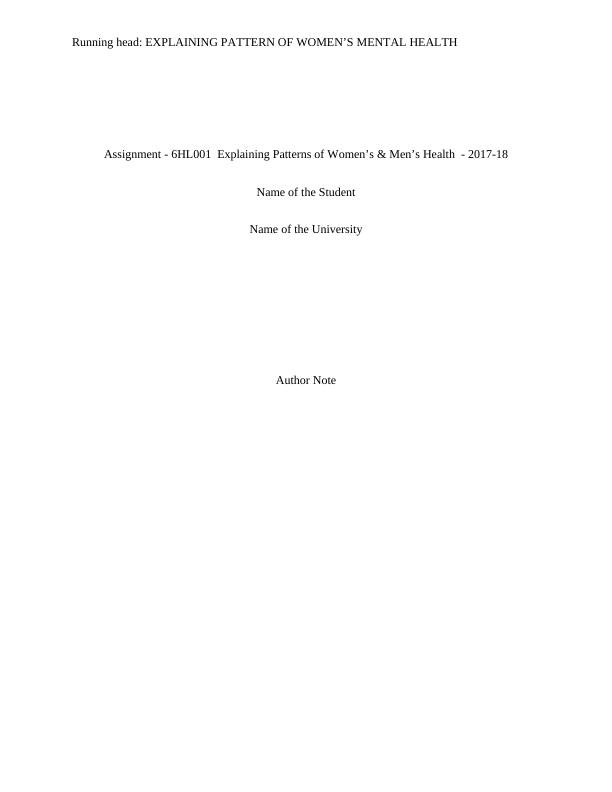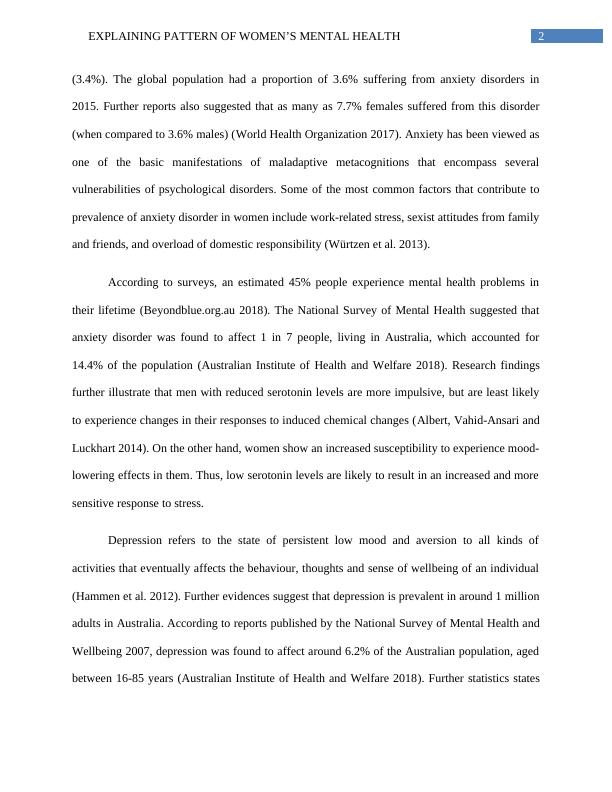Explaining Pattern of Women’s Mental Health
Added on 2023-06-15
8 Pages2217 Words208 Views
Running head: EXPLAINING PATTERN OF WOMEN’S MENTAL HEALTH
Assignment - 6HL001 Explaining Patterns of Women’s & Men’s Health - 2017-18
Name of the Student
Name of the University
Author Note
Assignment - 6HL001 Explaining Patterns of Women’s & Men’s Health - 2017-18
Name of the Student
Name of the University
Author Note

1EXPLAINING PATTERN OF WOMEN’S MENTAL HEALTH
Mental illness or disorder refers to psychiatric problems or behavioural mental patterns
that are responsible for bringing about significant impairment or distress of personal functioning.
Such problems are relapsing or persistent and are found to occur in the form or single or several
episodes (Clement et al. 2015). Most mental health problems usually affect men and women
equally. However, some of the mental disorders have been found to occur more among women.
There are a range of social factors that put women at an increased risk of suffering from poor
mental health status than men (Chambers et al. 2014). This essay will talk about higher
prevalence of anxiety and depression among women and will elaborate on relevant theory to
explain the same.
Anxiety and depression are associated with significant burden of mortality and morbidity
(Izard 2013). Gender is considered as an essential determinant of mental illness. Substantial
attention has been given to morbidity that is associated with several mental disorders, when
compared to than gender-specific mechanisms and determinants responsible for promoting and
protecting mental health. Gender is responsible for determining differential power and controls
gender over the major socioeconomic determinants that influence the mental health (Maguen et
al. 2012). Gender differences also create an impact on social position, lives, treatment and status
in the society and increase the exposure and susceptibility to specific mental health diseases.
Gender differences are particularly found to affect prevalence of anxiety, depression, and
somatic complaints (Eaton et al. 2012). These disorders are predominantly found among women
and affect 1 in 3 people, globally (Whiteford et al. 2013).
Anxiety disorders are defined by restlessness, extreme fear, and muscle tension and are
disabling or debilitating. This in turn increases the risk of depression and suicidal ideations
(Lader 2015). Anxiety disorder is ranked 6th in terms of its contribution to global disability
Mental illness or disorder refers to psychiatric problems or behavioural mental patterns
that are responsible for bringing about significant impairment or distress of personal functioning.
Such problems are relapsing or persistent and are found to occur in the form or single or several
episodes (Clement et al. 2015). Most mental health problems usually affect men and women
equally. However, some of the mental disorders have been found to occur more among women.
There are a range of social factors that put women at an increased risk of suffering from poor
mental health status than men (Chambers et al. 2014). This essay will talk about higher
prevalence of anxiety and depression among women and will elaborate on relevant theory to
explain the same.
Anxiety and depression are associated with significant burden of mortality and morbidity
(Izard 2013). Gender is considered as an essential determinant of mental illness. Substantial
attention has been given to morbidity that is associated with several mental disorders, when
compared to than gender-specific mechanisms and determinants responsible for promoting and
protecting mental health. Gender is responsible for determining differential power and controls
gender over the major socioeconomic determinants that influence the mental health (Maguen et
al. 2012). Gender differences also create an impact on social position, lives, treatment and status
in the society and increase the exposure and susceptibility to specific mental health diseases.
Gender differences are particularly found to affect prevalence of anxiety, depression, and
somatic complaints (Eaton et al. 2012). These disorders are predominantly found among women
and affect 1 in 3 people, globally (Whiteford et al. 2013).
Anxiety disorders are defined by restlessness, extreme fear, and muscle tension and are
disabling or debilitating. This in turn increases the risk of depression and suicidal ideations
(Lader 2015). Anxiety disorder is ranked 6th in terms of its contribution to global disability

2EXPLAINING PATTERN OF WOMEN’S MENTAL HEALTH
(3.4%). The global population had a proportion of 3.6% suffering from anxiety disorders in
2015. Further reports also suggested that as many as 7.7% females suffered from this disorder
(when compared to 3.6% males) (World Health Organization 2017). Anxiety has been viewed as
one of the basic manifestations of maladaptive metacognitions that encompass several
vulnerabilities of psychological disorders. Some of the most common factors that contribute to
prevalence of anxiety disorder in women include work-related stress, sexist attitudes from family
and friends, and overload of domestic responsibility (Würtzen et al. 2013).
According to surveys, an estimated 45% people experience mental health problems in
their lifetime (Beyondblue.org.au 2018). The National Survey of Mental Health suggested that
anxiety disorder was found to affect 1 in 7 people, living in Australia, which accounted for
14.4% of the population (Australian Institute of Health and Welfare 2018). Research findings
further illustrate that men with reduced serotonin levels are more impulsive, but are least likely
to experience changes in their responses to induced chemical changes (Albert, Vahid-Ansari and
Luckhart 2014). On the other hand, women show an increased susceptibility to experience mood-
lowering effects in them. Thus, low serotonin levels are likely to result in an increased and more
sensitive response to stress.
Depression refers to the state of persistent low mood and aversion to all kinds of
activities that eventually affects the behaviour, thoughts and sense of wellbeing of an individual
(Hammen et al. 2012). Further evidences suggest that depression is prevalent in around 1 million
adults in Australia. According to reports published by the National Survey of Mental Health and
Wellbeing 2007, depression was found to affect around 6.2% of the Australian population, aged
between 16-85 years (Australian Institute of Health and Welfare 2018). Further statistics states
(3.4%). The global population had a proportion of 3.6% suffering from anxiety disorders in
2015. Further reports also suggested that as many as 7.7% females suffered from this disorder
(when compared to 3.6% males) (World Health Organization 2017). Anxiety has been viewed as
one of the basic manifestations of maladaptive metacognitions that encompass several
vulnerabilities of psychological disorders. Some of the most common factors that contribute to
prevalence of anxiety disorder in women include work-related stress, sexist attitudes from family
and friends, and overload of domestic responsibility (Würtzen et al. 2013).
According to surveys, an estimated 45% people experience mental health problems in
their lifetime (Beyondblue.org.au 2018). The National Survey of Mental Health suggested that
anxiety disorder was found to affect 1 in 7 people, living in Australia, which accounted for
14.4% of the population (Australian Institute of Health and Welfare 2018). Research findings
further illustrate that men with reduced serotonin levels are more impulsive, but are least likely
to experience changes in their responses to induced chemical changes (Albert, Vahid-Ansari and
Luckhart 2014). On the other hand, women show an increased susceptibility to experience mood-
lowering effects in them. Thus, low serotonin levels are likely to result in an increased and more
sensitive response to stress.
Depression refers to the state of persistent low mood and aversion to all kinds of
activities that eventually affects the behaviour, thoughts and sense of wellbeing of an individual
(Hammen et al. 2012). Further evidences suggest that depression is prevalent in around 1 million
adults in Australia. According to reports published by the National Survey of Mental Health and
Wellbeing 2007, depression was found to affect around 6.2% of the Australian population, aged
between 16-85 years (Australian Institute of Health and Welfare 2018). Further statistics states

End of preview
Want to access all the pages? Upload your documents or become a member.
Related Documents
Depression as Mental Health Condition in United Kingdomlg...
|17
|5235
|389
Factors in public health PDFlg...
|9
|2543
|20
Mental Health Issues in Australia - Prevalence, Impact and Common Disorderslg...
|14
|974
|289
Depression in Women: Understanding the Causes and Treatmentlg...
|13
|3911
|348
Case Study of Georgia: Managing Anxiety Disorderlg...
|11
|3132
|293
Report on Mental Health Challenges Billlg...
|9
|2344
|44
